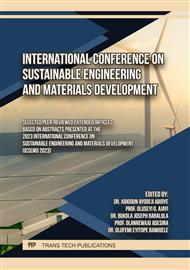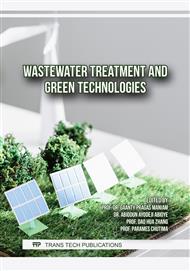[1]
Ahmed, A. F., Islam, M. Z., Mahmud, M. S., Sarker, M. E., & Islam, M. R. (2022). Hemp as a potential raw material toward a sustainable world: A review. Heliyon, e08753.
DOI: 10.1016/j.heliyon.2022.e08753
Google Scholar
[2]
Atbir, A., Khabbazi, A., Cherkaoui, M., Ibaaz, K., El Wardi, F. Z., & Chebli, S. (2023). Improvement of thermomechanical properties of porous plaster reinforced with a network of Morocco sheep wool skeletons for Energy efficiency. Building and Environment, 234, 110171.
DOI: 10.1016/j.buildenv.2023.110171
Google Scholar
[3]
Boity, A. K., Bhandari, H., & Shukla, S. (2022). Bamboo as a sustainable building construction material. Materials Today: Proceedings, 71, 306-311.
DOI: 10.1016/j.matpr.2022.09.218
Google Scholar
[4]
Cai, S., & Gou, Z. (2023). A comprehensive analysis of green building rating systems for data centers. Energy and Buildings, 284, 112874.
DOI: 10.1016/j.enbuild.2023.112874
Google Scholar
[5]
Cao, M. Q., Liu, T. T., Zhu, Y. H., Shu, J. C., & Cao, M. S. (2022). Developing electromagnetic functional materials for green building. Journal of Building Engineering, 45, 103496.
DOI: 10.1016/j.jobe.2021.103496
Google Scholar
[6]
Cortes, A., Almeida, J., de Brito, J., & Tadeu, A. (2019). Water retention and drainage capability of expanded cork agglomerate boards intended for application in green vertical systems. Construction and Building Materials, 224, 439-446.
DOI: 10.1016/j.conbuildmat.2019.07.030
Google Scholar
[7]
Cortes, A., Almeida, J., Tadeu, A., Ramezani, B., Fino, M. R., de Brito, J., & Silva, C. M. (2022). The effect of cork-based living walls on the energy performance of buildings and local microclimate. Building and Environment, 216, 109048.
DOI: 10.1016/j.buildenv.2022.109048
Google Scholar
[8]
Durdyev, S., Mohandes, S. R., Tokbolat, S., Sadeghi, H., & Zayed, T. (2022). Examining the OHS of green building construction projects: A hybrid fuzzy-based approach. Journal of Cleaner Production, 338, 130590.
DOI: 10.1016/j.jclepro.2022.130590
Google Scholar
[9]
Essaghouri, L., Mao, R., & Li, X. (2023). Environmental benefits of using hempcrete walls in residential construction: An LCA-based comparative case study in Morocco. Environmental Impact Assessment Review, 100, 107085.
DOI: 10.1016/j.eiar.2023.107085
Google Scholar
[10]
Jittin, V., Tripti, S. R., Bahurudeen, A., & Hammadhu, R. J. (2022). Cleaner construction of durable green rooftop in residential buildings with municipal water supply. Cleaner Materials, 5, 100125.
DOI: 10.1016/j.clema.2022.100125
Google Scholar
[11]
Koh, C. H. A., & Kraniotis, D. (2020). A review of material properties and performance of straw bale as building material. Construction and Building Materials, 259, 120385.
DOI: 10.1016/j.conbuildmat.2020.120385
Google Scholar
[12]
Koh, C. H. A., & Kraniotis, D. (2021). Hygrothermal performance, energy use and embodied emissions in straw bale buildings. Energy and Buildings, 245, 111091.
DOI: 10.1016/j.enbuild.2021.111091
Google Scholar
[13]
Liu, H., & Lin, B. (2016). Ecological indicators for green building construction. Ecological indicators, 67, 68-77.
DOI: 10.1016/j.ecolind.2016.02.024
Google Scholar
[14]
Liu, T., Ma, G., & Wang, D. (2022). Pathways to successful building green retrofit projects: Causality analysis of factors affecting decision making. Energy and Buildings, 276, 112486.
DOI: 10.1016/j.enbuild.2022.112486
Google Scholar
[15]
Mohan, N., Dash, S. P., Boby, N. M., & Shetty, D. (2022). Study of bamboo as a building material–Construction & preservation techniques and its sustainability. Materials Today: Proceedings, 60, 100-114.
DOI: 10.1016/j.matpr.2021.12.263
Google Scholar
[16]
Novais, R. M., Carvalheiras, J., Senff, L., Lacasta, A. M., Cantalapiedra, I. R., Giro-Paloma, J., & Labrincha, J. A. (2020). Multifunctional cork–alkali-activated fly ash composites: A sustainable material to enhance buildings' energy and acoustic performance. Energy and Buildings, 210, 109739.
DOI: 10.1016/j.enbuild.2019.109739
Google Scholar
[17]
Parlato, M. C., Porto, S. M., & Valenti, F. (2022). Assessment of sheep wool waste as new resource for green building elements. Building and Environment, 225, 109596.
DOI: 10.1016/j.buildenv.2022.109596
Google Scholar
[18]
Ramakrishnan, J., Liu, T., Zhang, F., Seshadri, K., Yu, R., & Gou, Z. (2023). A decision tree- based modeling approach for evaluating the green performance of airport buildings. Environmental Impact Assessment Review, 100, 107070.
DOI: 10.1016/j.eiar.2023.107070
Google Scholar
[19]
Saka, N., Olanipekun, A. O., & Omotayo, T. (2021). Reward and compensation incentives for enhancing green building construction. Environmental and Sustainability Indicators, 11, 100138.
DOI: 10.1016/j.indic.2021.100138
Google Scholar
[20]
Sangmesh, B., Patil, N., Jaiswal, K. K., Gowrishankar, T. P., Selvakumar, K. K., Jyothi, M. S., ... & Kumar, S. (2023). Development of sustainable alternative materials for the construction of green buildings using agricultural residues: A review. Construction and Building Materials, 368, 130457.
DOI: 10.1016/j.conbuildmat.2023.130457
Google Scholar
[21]
Shehata, N., Mohamed, O. A., Sayed, E. T., Abdelkareem, M. A., & Olabi, A. G. (2022). Geopolymer concrete as green building materials: Recent applications sustainable development and circular economy potentials. Science of the Total Environment, 155577.
DOI: 10.1016/j.scitotenv.2022.155577
Google Scholar
[22]
Wu, X., Cao, Y., Liu, W., He, Y., Xu, G., Chen, Z. S., ... & Skibniewski, M. J. (2023). BIM- driven building greenness evaluation system: An integrated perspective drawn from model data and collective experts' judgments. Journal of Cleaner Production, 136883.
DOI: 10.1016/j.jclepro.2023.136883
Google Scholar
[23]
Xu, P., Zhu, J., Li, H., Xiong, Z., & Xu, X. (2023). Coupling analysis between cost and carbon emission of bamboo building materials: A perspective of supply chain. Energy and Buildings, 280, 112718.
DOI: 10.1016/j.enbuild.2022.112718
Google Scholar
[24]
Xu, X., Xu, P., Zhu, J., Li, H., & Xiong, Z. (2022). Bamboo construction materials: Carbon storage and potential to reduce associated CO2 emissions. Science of the Total Environment, 814, 152697.
DOI: 10.1016/j.scitotenv.2021.152697
Google Scholar
[25]
Yang, Z., Chen, H., Mi, L., Li, P., & Qi, K. (2021). Green building technologies adoption process in China: how environmental policies are reshaping the decision-making among alliance-based construction enterprises?. Sustainable Cities and Society, 73, 103122.
DOI: 10.1016/j.scs.2021.103122
Google Scholar
[26]
Yu, B., & Fingrut, A. (2022). Sustainable building design (SBD) with reclaimed wood library constructed in collaboration with 3D scanning technology in the UK. Resources, Conservation and Recycling, 186, 106566.
DOI: 10.1016/j.resconrec.2022.106566
Google Scholar
[27]
Yue, X., Zhang, R., Jin, X., Zhang, X., Bao, G., & Qin, D. (2023). Bamboo-derived phase change material with hierarchical structure for thermal energy storage of building. Journal of Energy Storage, 62, 106911.
DOI: 10.1016/j.est.2023.106911
Google Scholar
[28]
Zhang, R., Tang, Y., Zhang, Y., & Wang, Z. (2023). Collaborative relationship discovery in green building technology innovation: Evidence from patents in China's construction industry. Journal of Cleaner Production, 391, 136041.
DOI: 10.1016/j.jclepro.2023.136041
Google Scholar
[29]
Zhang, X., & Mohandes, S. R. (2020). Occupational Health and Safety in green building construction projects: A holistic Z-numbers-based risk management framework. Journal of cleaner production, 275, 122788.
DOI: 10.1016/j.jclepro.2020.122788
Google Scholar
[30]
Zhao, Y., Liu, L., & Yu, M. (2023). Comparison and analysis of carbon emissions of traditional, prefabricated, and green material buildings in materialization stage. Journal of Cleaner Production, 137152.
DOI: 10.1016/j.jclepro.2023.137152
Google Scholar



